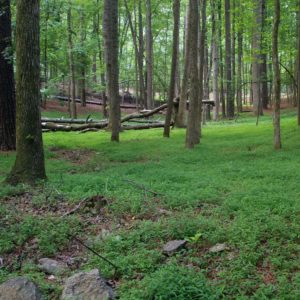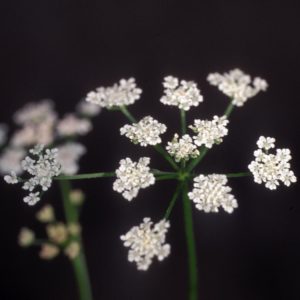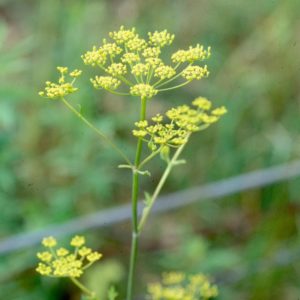This article was written by Mollie Flanigan, Land Stewardship Coordinator, and previously appeared in the Summer 2017 Long Trails News.
Spread the Word, Not the Plants!
How Hikers Can Help
Vermont’s forests are celebrated for diverse plant and animal life. From spring ephemeral wildflowers and choruses of songbirds to brilliant fall colors and moose trotting along the treadway, Vermont’s rich ecosystems help make the Long Trail and other footpaths exciting places for exploration.
This diversity, however, is threatened by non-native invasive plants. Elizabeth Spinney, the Invasive Species Coordinator for the Vermont Department of Forest, Parks and Recreation, recently gave me an overview on the threat these plants pose to Vermont’s mountains. Elizabeth oversees the outreach and education efforts in the state to provide information about the impact of invasive plants and connect Vermonters with the resources they need to take action.
“Invasive plants are non-native plants, introduced into an ecosystem they didn’t evolve in, where they cause harm to things we value, like the environment, economy or human health,” Elizabeth explained. “Not all non-native plants are invasive, but the ones that are tend to have characteristics which enable them to grow in a variety of conditions, such as high seed yield and viability; shade and sun tolerance; early leaf out and later leaf loss.” People introduce non-native plants to new ecosystems, either by intentional planting or inadvertently moving seeds or tissues. Once established, they can change landscapes dramatically.
What does this mean for species diversity? Elizabeth elaborated that invasive plants typically do not have natural predators, competitors, or diseases, which allows them to become established quickly, and can result in native plants being unable to compete. Invasive plants may disrupt more than the composition of species in an ecosystem. They can change the functionality of forest succession, water absorption, nutrient cycling, and soil chemistry.
Invasive plants can also harm human health. Lyme disease is an example: “Research is finding that heavy infestations of barberry—a thorny, multi-branching invasive shrub—can lead to an increased prevalence of ticks infected with Lyme disease-causing bacteria,” said Elizabeth. “This seems to be because ticks utilize the habitat created by barberry for part of their life cycle. The dense thickets of barberry make a refuge for the white-footed mouse. These mice are an alternate host for Lyme disease and a food source for larval ticks. So, with more mice and ticks crossing paths, you see a higher level of Lyme disease-carrying ticks in the tick population.”
The threat of invasive plants is a landscape-scale problem because plants don’t stay within property or town lines. We’re fortunate that invasive plants are not yet well-established at higher elevations in the Green Mountains, so we have a chance to prevent or slow their spread into the Long Trail corridor. But this will require an informed hiking community and consistent effort by everyone.
We can all help limit the spread of invasive plants by taking the following steps:
- Know common invaders. Visit VTinvasives.org to learn what invasive plants are a concern in Vermont and how to identify them.
- Stay on the trail. Hikers are most likely to spread invasive plants by picking up their seeds in boot treads or on clothing. Staying on the trail limits the number of seeds picked up.
- Avoid walking and camping on invasive plants. Herbaceous invasive plants may create an inviting green mat to camp on, but avoid these spots. The more time you spend near invasive plants, the more likely you are to pick up their seeds and spread them.
- Check your gear, clothing, and pets for seeds after each day hike, or periodically as you thru-hike. After hiking brush off boots, clothes, and pets to dislodge attached seeds. If you are thru-hiking, choose a periodic land mark, like trailheads, to brush off yourself and your gear. A stiff brush works best, but your hand or a cloth can also work. Seeds can collect in the dust at the bottom of your tent, so be sure to shake your tent before packing it.
- Spread the word, not the plants! Look for opportunities to educate other hikers. Use a friendly, non-confrontational tone and manner. You can also help to map and report invasive plants. Visit the Mapping for Healthy Forests Project on the iNaturalist.org website.
“By taking these simple precautions, together we can help to protect the woods and trails we all value,” Elizabeth concluded.
Invasive Plants of Concern for Vermont Trails
 Japanese Stiltgrass
Japanese Stiltgrass
This grove might look like a perfect place to pitch your tent,, but think again: it is blanketed with Japanese stiltgrass (Microstegium vimineum). Japanese stiltgrass is not known to occur in Vermont, and we want to keep it that way! When it invades a site, it can quickly crowd out native plants. Invasions can also change soil nutrient cycling processes, inhibit tree survival and growth, and reduce light availability. After it dies back in late fall it forms a long-lasting thick layer of smothering thatch. Because deer don’t much like it, they may browse remaining native vegetation more heavily.
 Wild Chervil
Wild Chervil
As you hike through meadows, pastures, and trailheads, keep an eye out for wild chervil (Anthriscus sylvestris). It grows well in rich, moist soils, and can reproduce through both seed and rooting of stems. Wild chervil’s aggressive growth enables it to outcompete native vegetation by forming extensive, dense stands. The small seeds are easily embedded in boot treads and dog fur, so be sure to check your gear, clothing, and pets after each hike.
 Wild Parsnip
Wild Parsnip
Don’t include this blossom in a midsummer bouquet! Wild parsnip (Pastinaca sativa) invades open, disturbed habitats like trailheads and the edges of parking areas. An infestation can spread and form dense stands. Wild parsnip sap often makes skin photosensitive, and subsequent sun exposure can cause severe blistering.
For more information about how you can help reduce the spread of these and other invasive plants, visit VTinvasives.org.
Learn more about all the natural communities on the Long Trail, as well as how to identify them, with GMC’s Nature Guide to Vermont’s Long Trail.
Photo Credits:
Japaneses Stiltgrass c. Chris Evans, University of Illinois, Bugwood.org.
Wild Chervil c. John Cardina, The Ohio State University, Bugwood.org.
Wild Parsnip c. John Cardina, The Ohio State University, Bugwood.org.



















Great article..can we write another one and add Hog Weed?